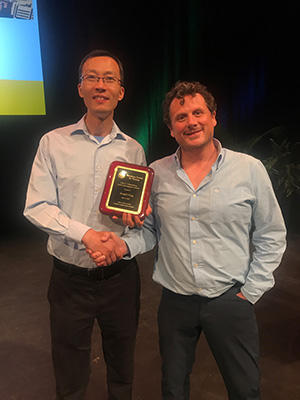Ann Palmenberg Junior Investigator Award Winner
Posted on August 28, 2019 by Microbiology Society
The Annual Meetings of the American Society for Virology aim to promote discussion and collaboration among scientists active in all aspects of virology. The Journal of General Virology sponsored the Ann Palmenberg Junior Investigator Award at the 38th Annual Meeting, held at the University of Minnesota in Minneapolis 20–24 July 2019. We spoke to the winner of the award; Zongdi Feng.

What was the title of your winning talk?
New insights into hepatitis E virus infection and immunobiology.
Who or what inspired you to be a scientist?
I have always been curious about how stuff works, but my career in virology started by accident. I was very interested in physics during high school. However, my score for the college entrance exam wasn’t high enough for the universities I chose, so I ‘voluntarily’ switched my major to Virology at Wuhan University, wrongly believing that it was about computer viruses (I had no knowledge about real viruses at that time). Although initially disappointed, I gradually became fascinated about life science and have been stuck with viruses ever since. I guess that decision was not so bad after all, since I have found infinite joy in studying viruses.
What are you currently working on and what area of your research excites you the most?
Since I started my independent lab at Nationwide Children’s Hospital (Ohio, USA) in 2014, my research has been focused on understanding the molecular biology of hepatitis E virus (HEV) and how it counteracts the host defence system. HEV is rare in the United States but is prevalent in developing countries (each year approximately 20 million people become infected resulting in 70,000 deaths) and is an emerging health problem in many developed countries in Europe. Most human cases in developed countries are caused by zoonotic transmission of swine HEV via consumption of undercooked contaminated pig meat. Moreover, the virus often persists in patients with a compromised immune system. These patients can rapidly progress to developing liver cirrhosis (scarring of the liver). We are very interested in identifying the mechanisms that lead to HEV persistence, with the goal of improving treatments (no HEV-specific treatment is currently available). We found that HEV has a unique life cycle: it is excreted as naked particles into the faeces but circulates in the bloodstream as ‘quasienveloped’ particles that are not recognized by circulating neutralising antibodies. In addition, we recently discovered that HEV produces a large amount of decoy proteins to further compromise the antibody response. What excites me the most is the unique biology of HEV. Many questions we are studying have no precedent, which makes them both challenging and fun. It will be even more rewarding if some of the knowledge we acquired through these studies can be used in the betterment of human health.
How would you explain your talk to a child under 10?
Viruses are small parasites of our body that can make us very sick sometimes. Viruses have various sorts of tricks and weapons to cheat and fight our immune system. My work is to find what kinds of tricks and weapons hepatitis E virus, a liver-infecting virus, uses to cause problems in us.
What would you be doing in your career if you weren’t a scientist?
I may have ended up as a computer geek or a theoretical physicist if I hadn’t become a virologist.

